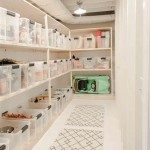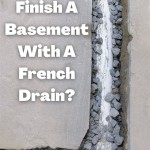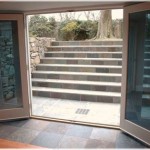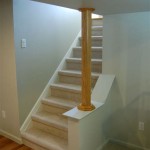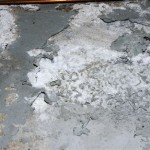Best Concrete Sealer for Interior Basement Walls
Basement walls constructed from concrete are susceptible to moisture intrusion, efflorescence, and mold growth. Applying a high-quality concrete sealer is a proactive measure to protect the structural integrity of the wall and improve the overall indoor air quality of the basement. Selecting the "best" concrete sealer necessitates an understanding of various sealer types, their properties, and the specific conditions of the basement environment. This article explores key considerations for selecting an appropriate concrete sealer for interior basement walls.
Understanding Concrete and Moisture
Concrete, by its nature, is a porous material. This porosity allows water vapor and liquid water to penetrate the concrete matrix. This can originate from several sources, including hydrostatic pressure from the surrounding soil, condensation due to temperature differences, and leaks from plumbing or the building's foundation. The consequences of moisture intrusion can be significant. Water can dissolve minerals within the concrete, leading to efflorescence – a white, powdery deposit on the surface. More seriously, prolonged exposure to moisture creates an environment conducive to mold and mildew growth, which can pose health risks and degrade indoor air quality. Furthermore, in colder climates, water trapped within the concrete can freeze and expand, leading to cracking and spalling, ultimately compromising the structural integrity of the wall.
Consequently, effective sealing is crucial. A suitable sealer will act as a barrier, preventing or significantly reducing moisture penetration and minimizing the associated problems. The selection process should consider the type of concrete, the level of moisture exposure, and the desired aesthetic finish.
Types of Concrete Sealers: Chemistry and Application
Several types of concrete sealers are available, each with distinct chemical compositions and performance characteristics. These include penetrating sealers (silicates, siloxanes, and silanes), film-forming sealers (acrylics and epoxies), and cementitious coatings. Understanding their properties is essential for informed decision-making.
Penetrating Sealers: These sealers work by penetrating the concrete surface and reacting chemically within the pores to create a hydrophobic barrier. This barrier repels water but still allows the concrete to "breathe", allowing water vapor to escape. This is particularly important in basements, where trapped moisture can lead to other problems. Common types of penetrating sealers include:
- Silicates: These react with calcium hydroxide in the concrete to form calcium silicate hydrate, which is a durable and water-resistant material. They are often used on older concrete surfaces.
- Siloxanes: These create a water-repellent surface by forming a chemical bond with the concrete. They are generally more resistant to degradation from UV exposure than silicates, although UV exposure is less of a concern for interior basement walls.
- Silanes: Similar to siloxanes, silanes are highly effective at repelling water and are often used in conjunction with siloxanes for enhanced protection. They also offer good resistance to chloride intrusion, which can be relevant if de-icing salts are used near the basement entrance.
Penetrating sealers are generally preferred for interior basement walls because they do not alter the appearance of the concrete and allow moisture vapor transmission, which can help prevent moisture buildup within the wall itself.
Film-Forming Sealers: These sealers create a protective layer on the surface of the concrete. While they provide a barrier against water intrusion, they can also trap moisture within the concrete, potentially leading to problems. Common types include:
- Acrylics: These are relatively inexpensive and easy to apply, but they are less durable and less resistant to chemicals than other types of sealers. They are also more likely to yellow over time.
- Epoxies: These provide a highly durable and chemical-resistant surface, but they are less permeable than penetrating sealers. They are often used in high-traffic areas or where chemical spills are likely.
Film-forming sealers are generally not recommended for interior basement walls unless specific performance characteristics, such as chemical resistance, are required. Their impermeability can trap moisture and lead to problems beneath the film.
Cementitious Coatings: These are cement-based products that are applied to the concrete surface to create a waterproof barrier. They are often used to repair cracks and imperfections in the concrete. These coatings can be effective, but their long-term performance depends on proper application and the stability of the underlying concrete.
The application method varies depending on the type of sealer. Penetrating sealers are typically applied with a sprayer or roller and allowed to soak into the concrete. Film-forming sealers are usually applied with a brush, roller, or sprayer, and multiple coats may be required. Cementitious coatings are applied with a trowel or brush.
Key Considerations for Selecting the Right Sealer
Choosing the appropriate concrete sealer involves careful consideration of several factors related to the basement environment and the desired outcome.
Moisture Levels and Hydrostatic Pressure: Assess the level of moisture exposure in the basement. If the basement is prone to dampness or experiences hydrostatic pressure, a penetrating sealer with excellent water-repellency properties is crucial. Look for products specifically designed for below-grade applications and that are formulated to withstand hydrostatic pressure. In situations where the basement wall actively exhibits water seepage, addressing the source of the water is paramount before applying any sealant. Exterior waterproofing measures may be necessary to alleviate hydrostatic pressure and prevent further water intrusion.
Concrete Condition and Preparation: The condition of the concrete surface is a critical factor in sealer effectiveness. Ensure the concrete is clean, dry, and free of any loose debris, efflorescence, or existing coatings. Clean the surface with a concrete cleaner and degreaser to remove any dirt, oil, or grease. Etching the concrete surface with a muriatic acid solution can improve the penetration and adhesion of the sealer. Thoroughly rinse the concrete after etching to remove any acid residue. Allow the concrete to dry completely before applying the sealer, as moisture can interfere with the curing process and reduce the sealer's effectiveness. Patch any cracks or imperfections in the concrete before applying the sealer to prevent moisture from penetrating through these areas.
Permeability vs. Impermeability: As previously discussed, the breathability of the sealer is a critical factor. In most basement applications, particularly those lacking efficient vapor barriers, it's preferable to select a sealer that allows moisture vapor transmission. Impermeable sealers can trap moisture within the concrete, potentially leading to spalling, cracking, and efflorescence. Penetrating sealers generally offer the best balance of water repellency and breathability. Evaluate the product's technical specifications to determine its permeability rating and ensure it aligns with the basement's environmental conditions. If an impermeable sealer is used, a robust interior drainage system and dehumidification strategy are necessary to manage trapped moisture.
Durability and Longevity: The durability and longevity of the sealer are important considerations to minimize reapplication frequency. Penetrating sealers typically offer longer-lasting protection compared to film-forming sealers. Select a sealer that is resistant to abrasion, chemicals, and UV exposure (although UV exposure is less of a concern for interior basement walls). Consider the manufacturer's warranty and product reviews to assess the sealer's expected lifespan. Regularly inspect the sealed surface for any signs of wear or damage and reapply the sealer as needed to maintain optimal protection.
Application and Safety: Carefully follow the manufacturer's instructions for application. Proper application is essential for achieving optimal sealer performance. Wear appropriate personal protective equipment (PPE), such as gloves, eye protection, and a respirator, during application, especially when working with solvent-based sealers. Ensure adequate ventilation in the basement to minimize exposure to fumes. Dispose of any leftover sealer and empty containers properly according to local regulations. Consider hiring a professional concrete sealing contractor for optimal results, especially for large or complex basement sealing projects.
Cost Considerations: The cost of concrete sealers can vary significantly depending on the type, quality, and quantity purchased. While it may be tempting to choose a cheaper option, investing in a high-quality sealer can provide long-term cost savings by preventing moisture damage and reducing the need for frequent repairs. Calculate the total cost of the project, including the cost of the sealer, application tools, and any necessary surface preparation materials. Obtain quotes from multiple suppliers to compare prices and ensure that you are getting the best value. Consider the long-term cost of maintenance and reapplication when evaluating the overall cost-effectiveness of different sealers.
By carefully considering these factors, homeowners can select the best concrete sealer for their interior basement walls, ensuring long-lasting protection against moisture damage and contributing to a healthier and more comfortable living environment.

Internal Concrete Sealer Timber Pro Coatings

Radonseal Plus 5 Gal Deep Penetrating Concrete Sealer For Foundations And Basement Floors 110 The Home

Radonseal Plus 5 Gal Deep Penetrating Concrete Sealer For Foundations And Basement Floors 110 The Home

Radonseal 5 Gal Plus Penetrating Concrete Sealer 110 The Home

Radonseal Plus 5 Gal Deep Penetrating Concrete Sealer For Foundations And Basement Floors 110 The Home

Deco 20 Clear Penetrating Concrete Sealer

Deco Healthy Walls Penetrating Concrete Sealer Products

Ames Block And Wall 1 Gal Liquid Rubber Waterproof Sealant Bwrf1 The Home

Waterproofing Basement Walls Dos And Don Ts To Remember Bob Vila

Radonseal Plus 5 Gal Deep Penetrating Concrete Sealer For Foundations And Basement Floors 110 The Home
